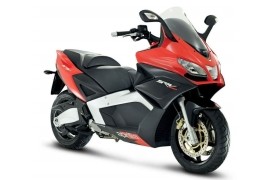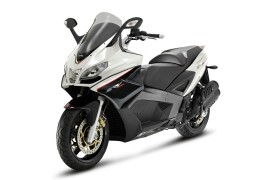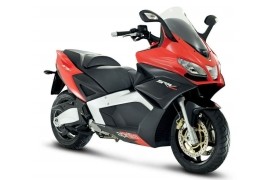APRILIA SRV Models/Series Timeline, Specifications & Photos
First production year: 2012
In 2014, the Italian motorcycle manufacturer released the Aprilia SRV 850 Maxi, a scooter that debuted in 2012 to replace Gilera's identical GP 800 model. It was the fastest series scooter until 2022 and continued production until 2016.
The 2014 model came in the same shape and form as the previous one, delivering the same technical, visual, and performance specifications without any significant modifications whatsoever.
The 2014 Aprilia SRV 850 Maxi had its soul brought to life by an 839cc four-stroke liquid-cooled V-twin engine, identical to the one that powered the Aprilia Mana 850, delivering 76 hp at 7,750 rpm and 76 Nm (56 lb-ft) torque at 6,000 rpm.
The power produced by the engine was redirected to the rear end through a CVT automatic transmission with a dry centrifugal clutch and a final belt drive, launching the scooter to a top speed of 193 kph (120 mph).
It was manufactured around a double-cradle high-strength tubular steel frame that housed a 41 mm telescopic fork on the front with 122 mm of travel and a seven-way adjustable monoshock mounted horizontally, acting as suspension.
As for the visual department, the scooter packed standard fittings, like a body covered with fairings, a dual headlight system, a medium-sized windscreen, a one-piece dual seat with rider lumbar support, a two-into-one exhaust system with a silencer mounted on the left-hand side, and five-spoke alloy wheels.
In 2013, the Italian motorcycle manufacturer released the Aprilia SRV 850 Maxi, a large displacement and one of the most powerful scooters available on the market at the time. It had an aerodynamic fairing and delivered sports-bike performance.
The Aprilia SRV 850 was a scooter manufactured by Aprilia in 2012 to replace the identical GP 800 model from Gilera and continued production until 2016. Until 2022, the SRV 850 was the fastest series scooter.
Aesthetically, the bike had standard features, such as a body covered with fairings, a dual headlight system, a medium-sized windscreen, a one-piece dual seat with rider lumbar support, a two-into-one exhaust system with a silencer mounted on the left-hand side, and five-spoke alloy wheels.
It was built around a double-cradle high-strength tubular steel frame that housed a 41 mm telescopic fork on the front with 122 mm of travel and a seven-way adjustable monoshock mounted horizontally, acting as suspension.
The stopping power was achieved by two 300 mm semi-floating stainless steel discs coupled to dual-piston Brembo calipers on the front and a 280 mm stainless steel disc tied to a dual-piston caliper, assisted by an Anti-Lock Braking System (ABS).
As for the power figures, the 2013 Aprilia SRV 850 Maxi had its soul brought to life by an 839cc four-stroke liquid-cooled V-twin engine that delivered 76 hp at 7,750 rpm and 76 Nm (56 lb-ft) torque at 6,000 rpm.
The Aprilia SRV 850 Maxiwas a scooter made by Aprilia in 2012 to replace the identical GP 800 model from Gilera and continued production until 2016. Until 2022, the SRV 850 was the fastest series scooter.
The 2012 Aprilia SRV 850 Maxi was powered by an 839cc four-stroke liquid-cooled V-twin engine that delivered 76 hp at 7,750 rpm and 76 Nm (56 lb-ft) torque at 6,000 rpm. The engine was identical to the one that powered the Aprilia Mana 850.
The power generated by the engine was redirected to the rear end through a CVT automatic transmission with a dry centrifugal clutch and a final belt drive, launching the scooter to a top speed of 193 kph (120 mph).
Visually, the scooter was characterized by standard features, such as a body covered with fairings, a dual headlight system, a medium-sized windscreen, a one-piece dual seat with rider lumbar support, and five-spoke alloy wheels.
The scooter was built around a double-cradle high-strength tubular steel frame that housed a 41 mm telescopic fork on the front with 122 mm of travel and a seven-way adjustable monoshock mounted horizontally.
As for the braking power, the scooter's wheels were fitted with two 300 mm semi-floating stainless steel discs coupled to dual-piston Brembo calipers on the front and a 280 mm stainless steel disc tied to a dual-piston caliper, assisted by an Anti-Lock Braking System (ABS).


